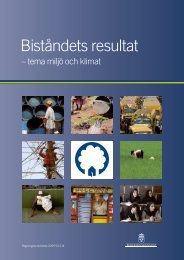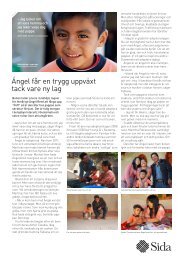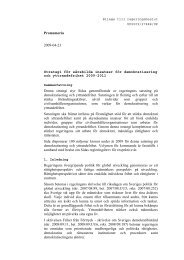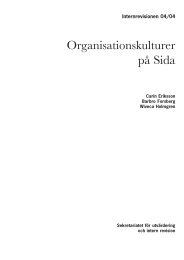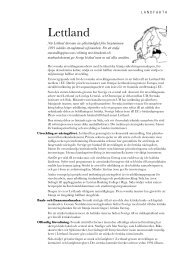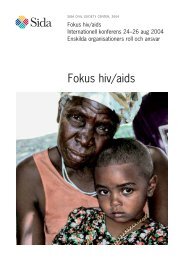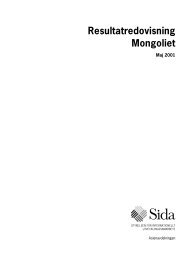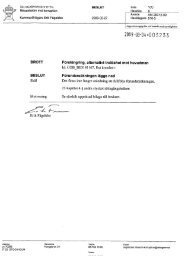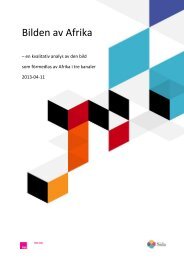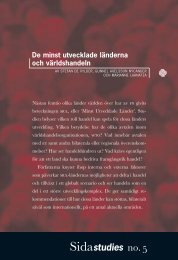Mobilisation of the Poor – a means to Poverty Reduction? - Sida
Mobilisation of the Poor – a means to Poverty Reduction? - Sida
Mobilisation of the Poor – a means to Poverty Reduction? - Sida
You also want an ePaper? Increase the reach of your titles
YUMPU automatically turns print PDFs into web optimized ePapers that Google loves.
First, instead <strong>of</strong> a consistent progress or consistent decline, CAP activities in <strong>the</strong> two areas<br />
experienced many ebbs and flows in <strong>the</strong> period under review.<br />
Second, while CAP activities declined considerably because <strong>of</strong> shifts in management and <strong>the</strong><br />
termination <strong>of</strong> <strong>Sida</strong> funds in <strong>the</strong> 1990s, <strong>the</strong> programme was somewhat stabilised by 2001.<br />
Third, this stabilisation may be at least partly attributable <strong>to</strong> <strong>the</strong> ability <strong>of</strong> <strong>the</strong> respective POs <strong>to</strong><br />
successfully secure funds from new donors, but this also reflects a degree <strong>of</strong> dynamism on <strong>the</strong> part <strong>of</strong><br />
PO leaders and a degree <strong>of</strong> success in retaining/building group funds in <strong>the</strong> interim period. Even<br />
though one can argue that injection <strong>of</strong> external funds from time <strong>to</strong> time has been a key fac<strong>to</strong>r in <strong>the</strong><br />
resuscitation <strong>of</strong> <strong>the</strong> programme, this cannot be seen as <strong>the</strong> only fac<strong>to</strong>r in <strong>the</strong> persistence <strong>of</strong> <strong>the</strong><br />
group process. While many small groups have fallen by <strong>the</strong> wayside, some have remained resilient<br />
so that <strong>the</strong> programme was able <strong>to</strong> bounce back once conditions became favorable. This in turn<br />
makes it necessary for us <strong>to</strong> examine <strong>the</strong> small group process more closely.<br />
The small group process<br />
Some aspects <strong>of</strong> <strong>the</strong> actual operation <strong>of</strong> <strong>the</strong> small group process can be assessed by examining<br />
actual cases <strong>of</strong> selected locations.<br />
24<br />
Case 3: Example <strong>of</strong> a Successful CAP Small Group<br />
The Peraliya Small Group was considered one <strong>of</strong> <strong>the</strong> more successful in Peraliya GS in <strong>the</strong> Hikkaduwa PO <strong>of</strong><br />
Galle District. This all-female small group consisted <strong>of</strong> 10 members. In <strong>the</strong> coastal village <strong>of</strong> Peraliya most<br />
men were engaged in fishing while most women from poorer families were engaged in coir yarn making. The<br />
group was formed in 1992 under <strong>the</strong> influence <strong>of</strong> a change agent from a nearby village.<br />
One member <strong>of</strong> <strong>the</strong> group, Pathma, was considered its leader. Of <strong>the</strong> 10 women in <strong>the</strong> group, three were<br />
related in some way. The o<strong>the</strong>rs knew each o<strong>the</strong>r as neighbours. They were all engaged in coir work, a<br />
cottage industry practiced exclusively by women. Asked why <strong>the</strong>y came <strong>to</strong>ge<strong>the</strong>r as a group, Pathma<br />
mentioned that relieving <strong>the</strong> credit burden <strong>of</strong> members and promoting social harmony and awareness among<br />
women were <strong>the</strong> main objectives <strong>of</strong> <strong>the</strong> group process. Depending on patterns <strong>of</strong> mutual trust, <strong>the</strong><br />
participants voluntarily selected <strong>the</strong> groups <strong>the</strong>y wanted <strong>to</strong> join. In <strong>the</strong> village <strong>of</strong> Peraliya, 105 women formed<br />
13 small groups and three GS organisations. The local change agents spent a long time with each <strong>of</strong> <strong>the</strong><br />
groups <strong>to</strong> help <strong>the</strong>m identify <strong>the</strong>ir common problems and jointly work <strong>to</strong>wards <strong>the</strong>ir solutions.<br />
At <strong>the</strong> beginning each member <strong>of</strong> <strong>the</strong> Peraliya group saved Rs.2 per week in <strong>the</strong> group fund. Later it rose <strong>to</strong><br />
Rs.5 per week and finally <strong>to</strong> Rs.10. In <strong>the</strong> early phase <strong>the</strong>y also collected a measure <strong>of</strong> rice from each<br />
member household every week <strong>to</strong> create a group fund <strong>to</strong> bulk buy rice for <strong>the</strong> group during <strong>the</strong> New Year<br />
period, but by 2001 this practice <strong>of</strong> rice collection had s<strong>to</strong>pped. The accumulated savings <strong>of</strong> <strong>the</strong> group as <strong>of</strong><br />
2001 was Rs.35,000. This accumulated group fund enhanced <strong>the</strong> sense <strong>of</strong> common interest and was <strong>of</strong>ten<br />
mentioned as an index <strong>of</strong> solidarity within <strong>the</strong> group. The funds generated by <strong>the</strong> group had been used <strong>to</strong><br />
lend money <strong>to</strong> group members at <strong>the</strong> rate <strong>of</strong> 5 per cent interest per month, and <strong>to</strong> known outsiders at <strong>the</strong><br />
rate <strong>of</strong> 10 per cent interest per month. The members were paid 2 per cent interest per month for <strong>the</strong>ir<br />
savings. The group leader maintained systematic records <strong>of</strong> savings, lending, interest payments and any<br />
o<strong>the</strong>r financial operations. The group had paid membership fees <strong>of</strong> <strong>the</strong> local GS, and some members <strong>of</strong> <strong>the</strong><br />
group had saved money in <strong>the</strong> GS, but <strong>the</strong>y had not borrowed any money from <strong>the</strong> GS or PO, opting <strong>to</strong> rely<br />
on <strong>the</strong>ir own financial resources.<br />
MOBILISATION OF THE POOR <strong>–</strong> A MEANS TO POVERTY REDUCTION <strong>–</strong> <strong>Sida</strong> EVALUATION 02/08




